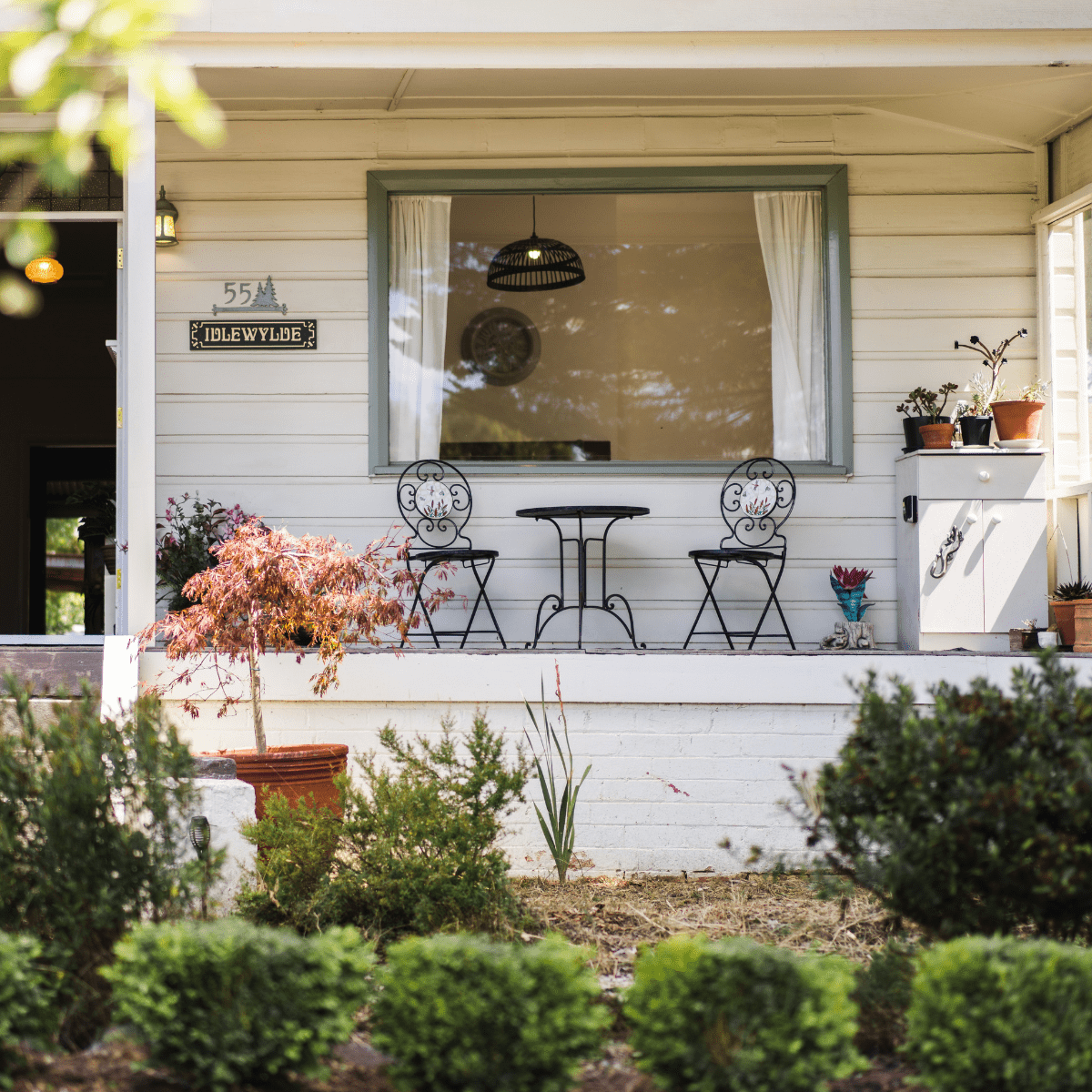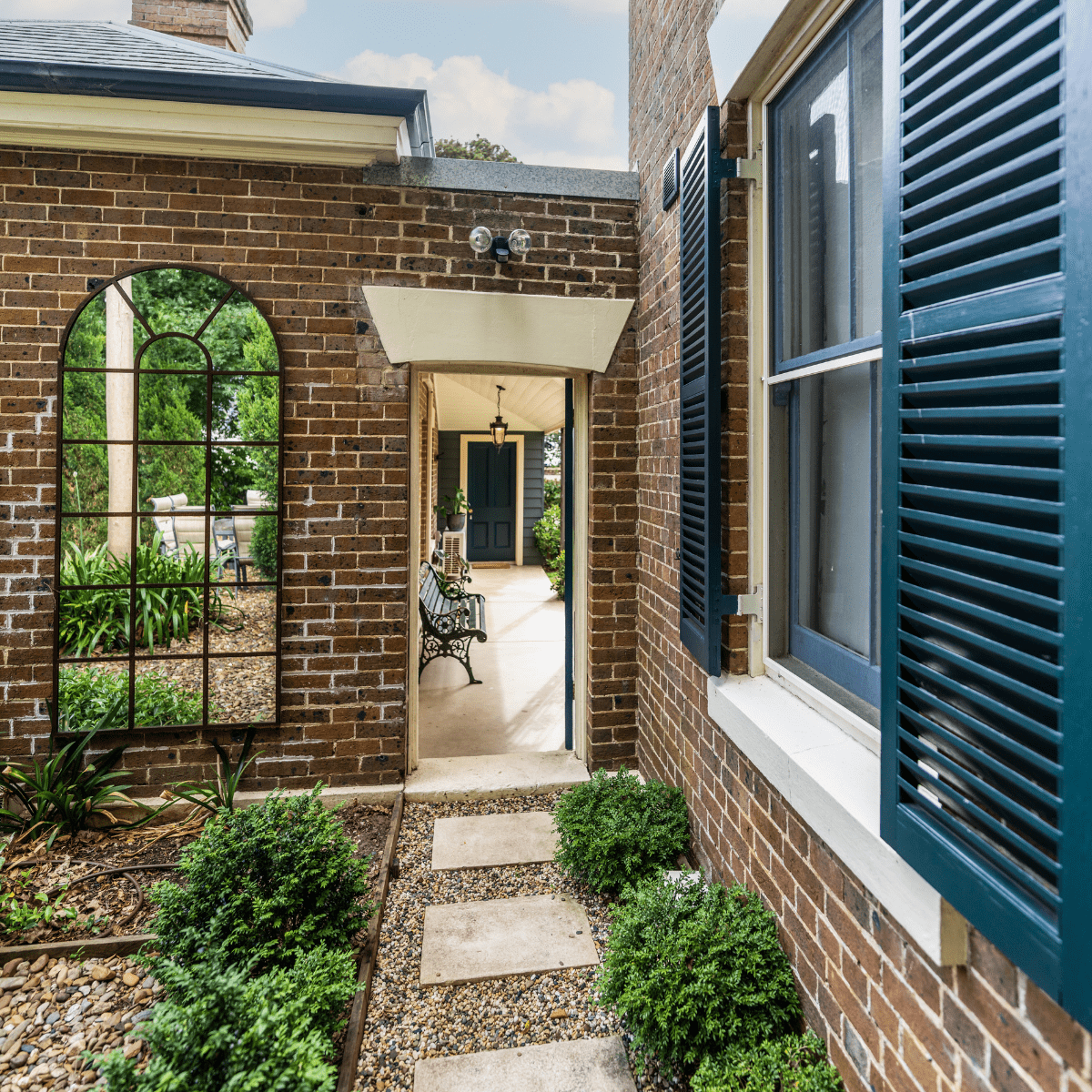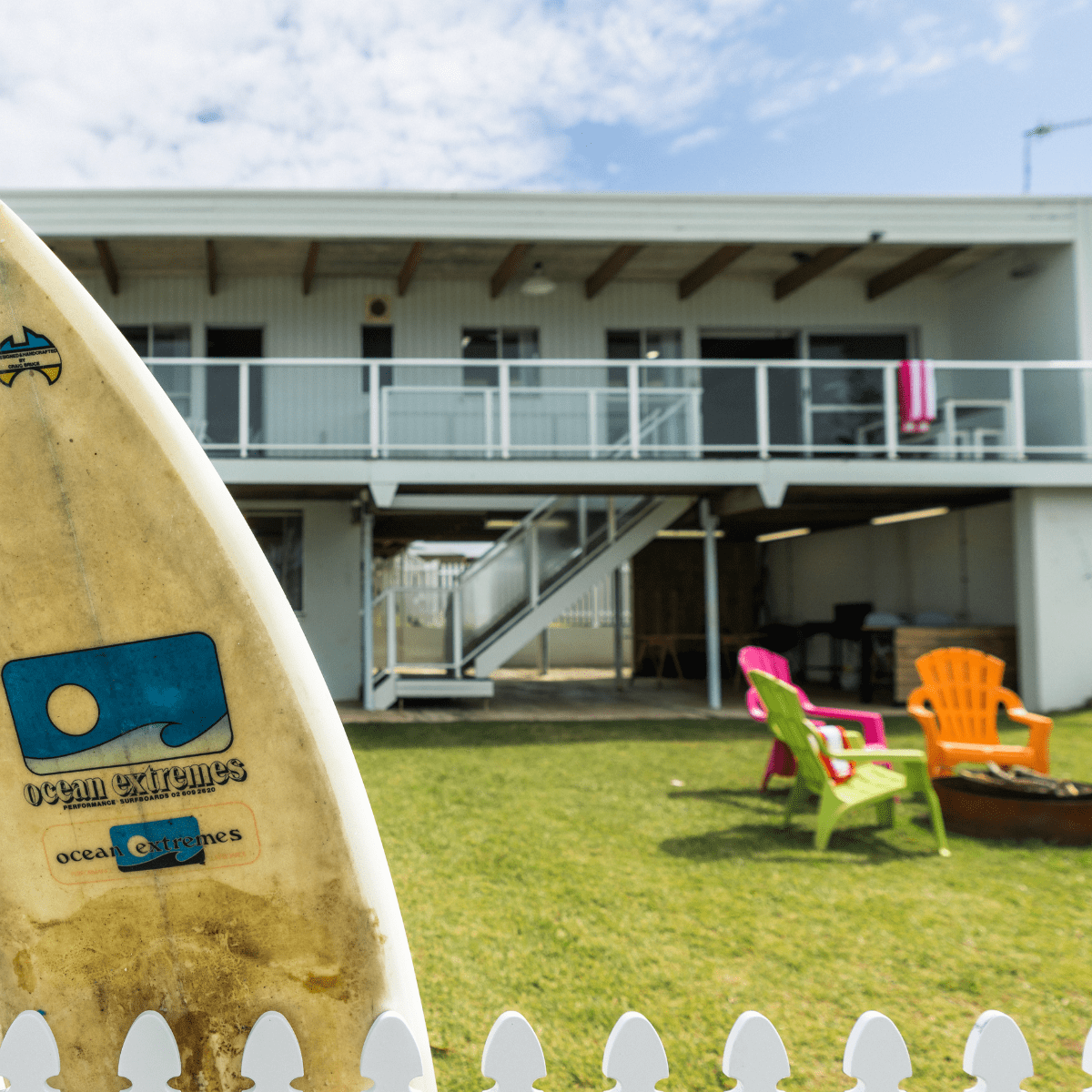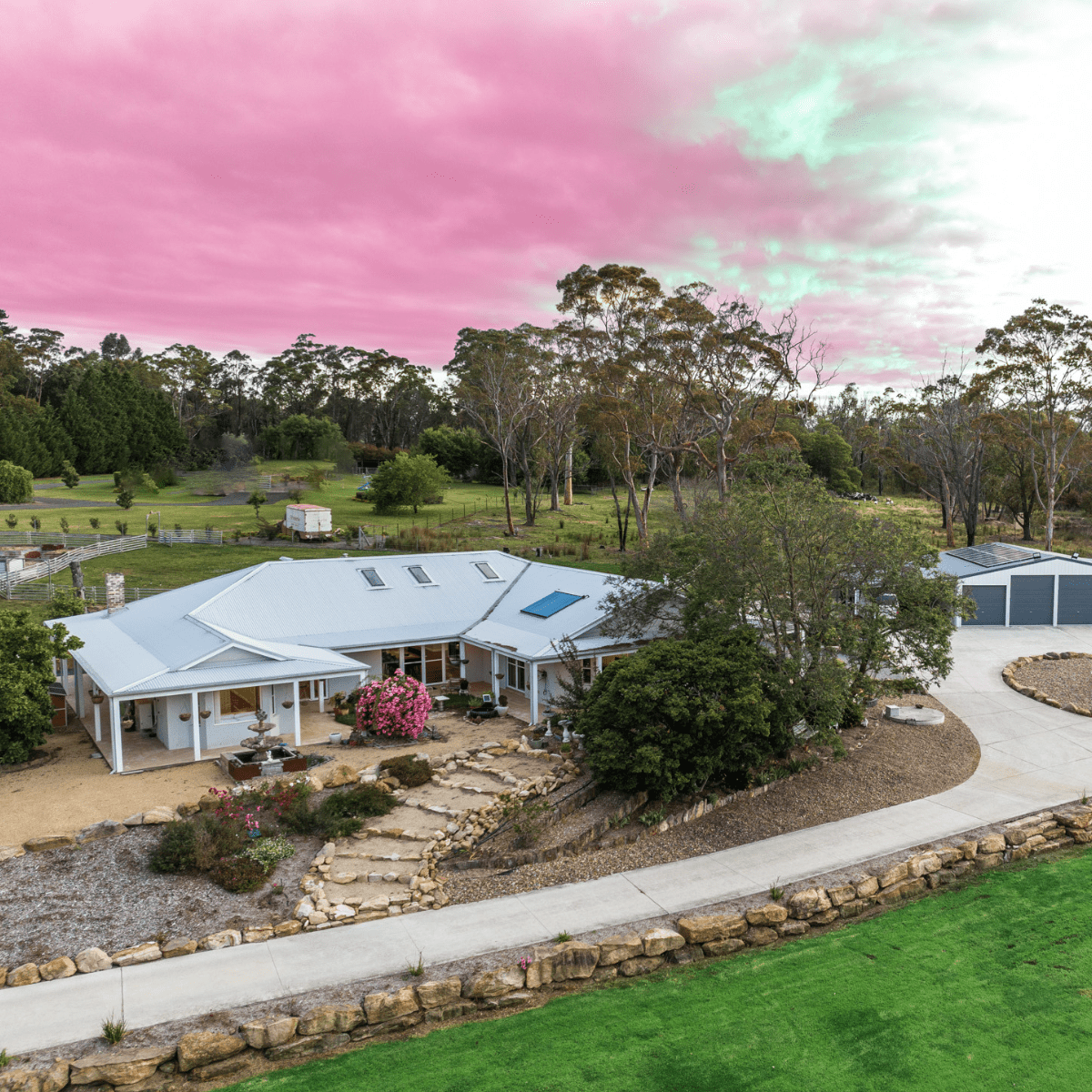The Origin Story – Dr Crookston’s House, Camden
A curious tale of the origin of an iconic Camden home – Period between 1876 to 1882.
Dr Crookston’s house as it is colloquially known in the township of Camden, sits proudly atop of John Street. Positioned significantly under the nostalgic gaze of St Johns Anglican Church. Even though a sizeable property at one of the highest and central points in this old English style town, it hides itself away, screened by a myriad of well-established trees, that although old, are only mere adolescents compared to the age of such a home. Dr Crookston’s house has a proud history within the township, and as per the request by Camden’s very own royalty – Sir William Macarthur who commissioned and financed the build, the home was to be a substantial structure ornamental to the town.
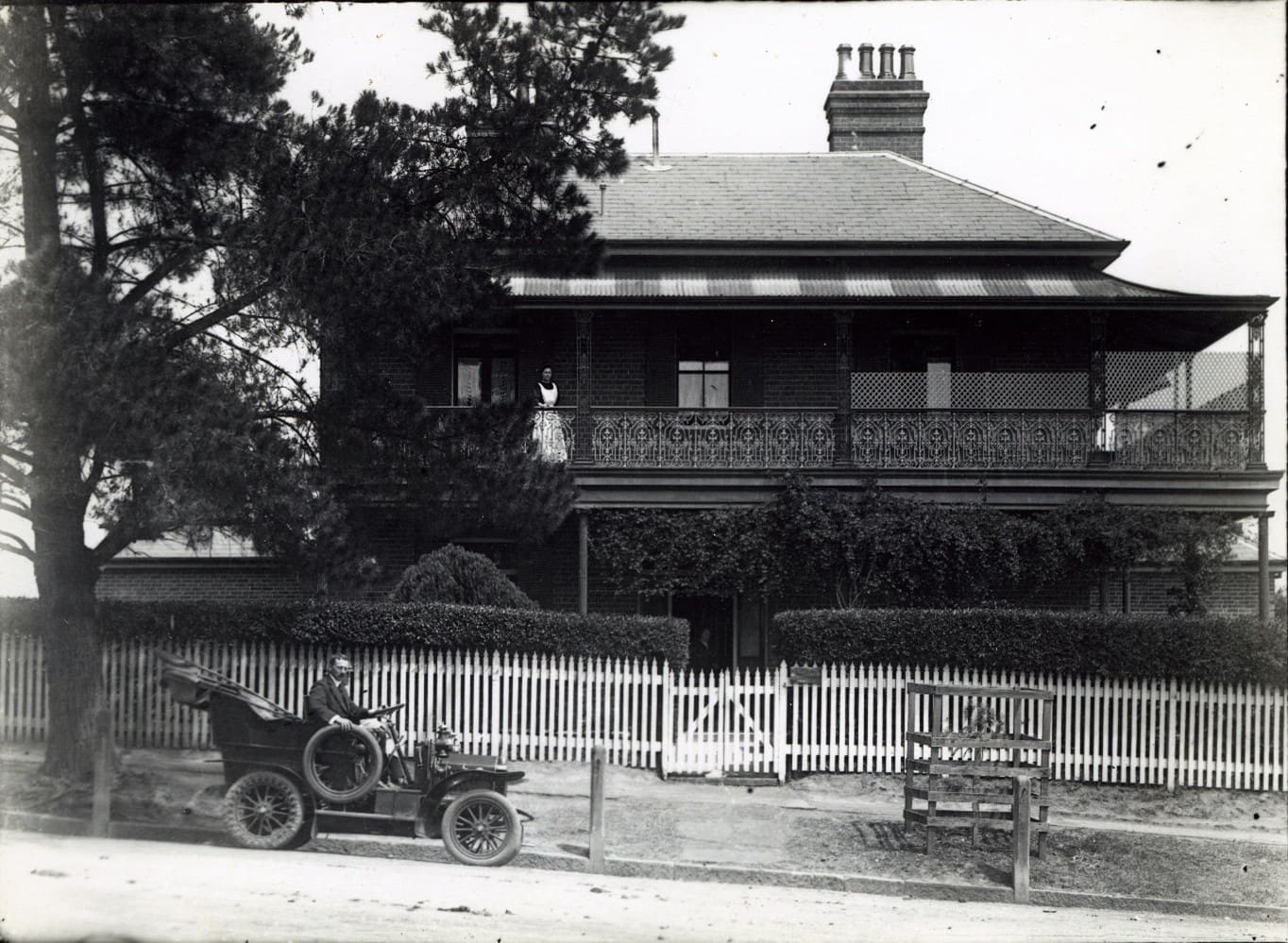
Picture Circa 1909 Dr Basil Foulds resides in home – Dr Foulds a known motorcar enthusiast.
The construction of Dr Crookston’s house appeared to commence by January 1878 and was completed by sometime in 1880. Much mystery has always shrouded why such a grand residence would be built? for what purpose? And who was it built for? It is these questions that I will try to unravel, slowly as I have travelled down the rabbit hole, my thirst for knowledge about this magnificent building, has swept my mind away for countless hours across many nights. Transported to another time, learning about many colourful characters, and being immersed in lives of those that walked before us. My imagination can’t but help paint pictures of a kaleidoscope like community – being formed so beautifully but forever shifting with any slight movement. Whether that be conquest, advancement, innovation, revenge, or betrayal. It appears the history of Dr Crookston’s house is immersed in it all! As the adage goes, if only the walls could talk.
Village gossip, passed down through generations, has always led to the same conclusion, that Dr Crookston’s house was believed to be built for a certain Camden Park Estate farm manager, by the name Robert Henry Druitt. It can be safely said that this is most definitely NOT the case. Thanks to our current digital age, we now have easy access to a vast collection of historical records that reference Dr Crookston’s house. Another benefit is our locally assembled accounts at Camden Museum, which in truth are nothing short of amazing, having been gathered by many local volunteers, for numerous years, we now have access to a treasure trove of local information. The final piece to my current puzzle that I have been able to utilise is the Macarthur family Papers located in the Mitchell Library. These papers contain some of the most critical data in my quest to unearth the tales of this home and its inhabitants before me.
To lightly collate why NOT Robert Henry Druitt as the first tenant, here are some critical facts –
- Druitt did not become Camden Park Estate Farm Manager until 1895, some 15 years after the house was completed, so this clearly defines the home was never built for one R. H. Druitt.
- Articles found on trove show not till 1887, R. H. Druitt working in our district (Picton), and then at Spring Mills, The Oaks in early 1890s.
- Through the early 1890s he has heavy involvement at The Oaks, being president of a newly founded School of Arts. Also helping and serving at one of the Churches in The Oaks community.
- In 1899 as reported by the Camden News“The sad fatality occurred at a small horse or bull paddock adjoining the farm manager’s residence on the estate, substantially constructed; some 50 yards away.” The estate being mentioned earlier in the article as Camden Park Estate and the farm manager being mentioned as R.H. Druitt. This shows his home to be located at Camden Park Estate.
- An excellent article from Camden History – Journal of the Camden Historical Society – March 2021, Volume 5, Number 1 – prints a letter by Ada Australia Goldsmith, Ada is the sister in-law of Robert Henry Druitt and talks of how in 1895 Druitt becomes manager of Camden Park Estate. Ada discusses how she spent much time visiting her sister at their residence on the Camden Park Estate, which was the original building occupied by John Macarthur at the end of his life. This letter supports facts previously mentioned and even supplies us with detail of exactly where Druitt resided.
In conclusion with the facts above, it makes sense for a farm manager of Camden Park Estate to live on the property he is looking after. To have resided in town, such a far distance from affairs, would just not be practical. It could be imagined that Druitt would have been on call 24 hours, 7 days a week and would have been required to attend to all sorts of farm matters, day, or night, in service for the Macarthur family.
This leads us to the most exciting part; well, I think anyway. Now that we know, Robert Henry Druitt never resided at Dr Crookston’s house, Pandora’s box lifts its sneaky lid regarding the history of Dr Crookston’s house, and how it came to be. Curious tales and stories of a bygone era dance across my mind, inflicting sleepless nights as scattered fragments of information, try to form sense of what once was. On the surface an idyllic landscape for pioneers and dream makers, whilst underneath the surface a growing society simmers with struggles for power, control and a self-asserted hierarchy being challenged to its core.

Drawing Circa 1880 see house top of John Street
Who was the house being built for? From an article January 1878 in the Cumberland Mercury relating to events in Camden it mentions that –
“Sir Will Macarthur is going to have a fine home built on the hill opposite the church as a residence, it is supposed, for Dr. Morton. The site is now being levelled, and the excavations made for the foundation. According to the plans it will be a handsome and substantial structure, and ornamental to the town.”

Sir William Macarthur

Captain Arthur Onslow
The uncomplicated answer is a doctor, although the doctor mentioned in the above article Dr Selby Mars Morton would never occupy the home. Dr Morton would return to Goulburn and continue his medical practice in this region. Dr Morton’s departure came as a shock to the town of Camden as “the fine house now being built on Church Hill, was intended for him.”.
It however still would be a doctor to first occupy the house. A lease found at The Mitchell Library, as part of the Macarthur Collection, dated December 1880, a certain Dr William John Jackson would take residency as tenant. Dr Jackson would lease the home from William
Macarthur executed on his behalf by James Kinghorn Chisholm for a rental fee of thirty pounds per quarter.
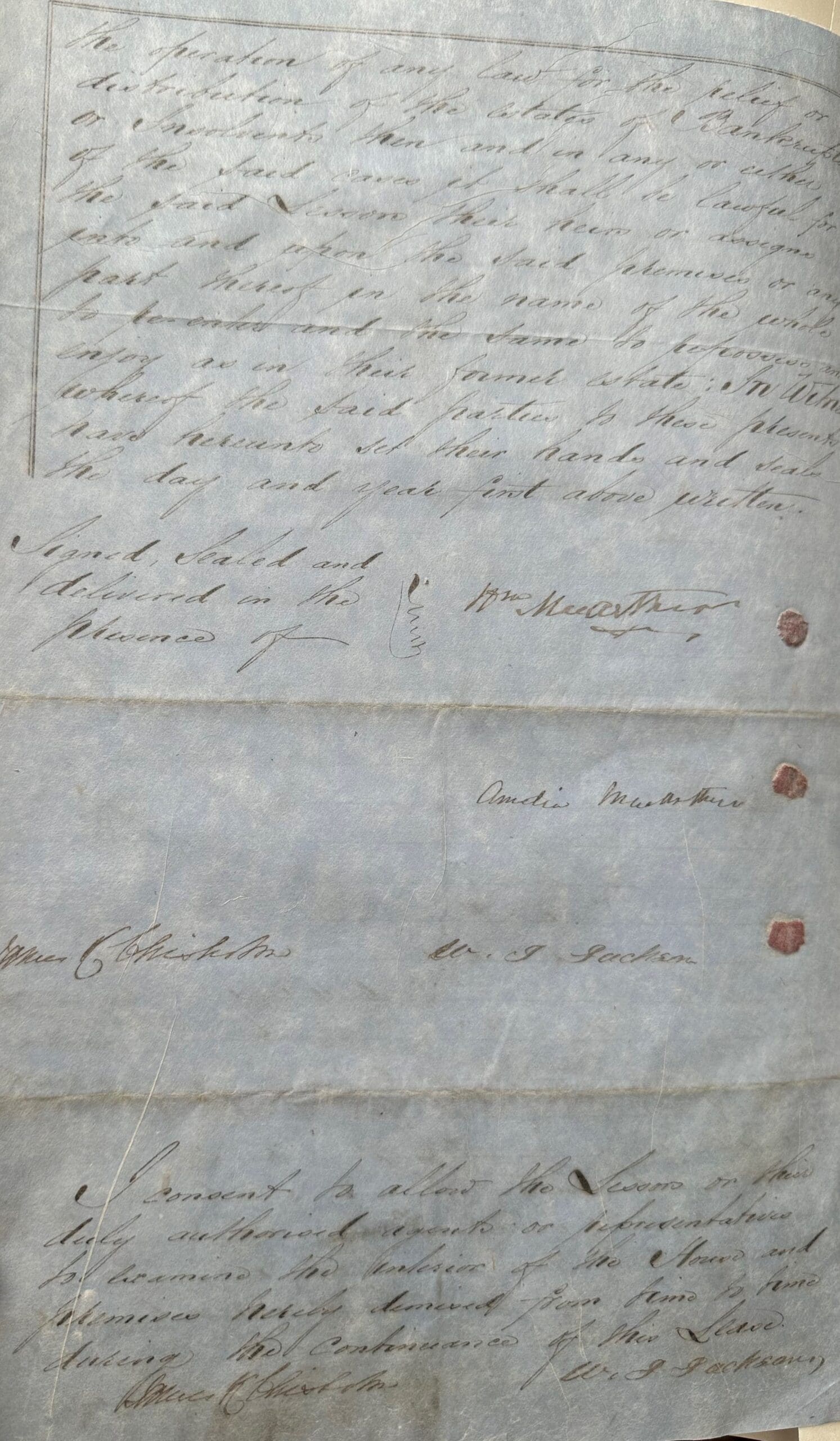
December 1880 Lease
It is wonderful to think that the home was always built for that of a doctor, considering its colloquially known name, and the fact it has been confirmed at least seven doctors have lived at the estate. The amount of years doctors have resided at the home accounts to roughly 100 years of occupation out of its current 144-year history.
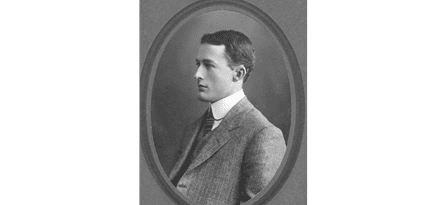
Picture Dr Robert Melville Crookston the doctor to occupy the home the longest.
From further records found in the Macarthur Papers, a building quote in 1888 from George Furner highlights the repainting of the whole home excluding the stables. It most importantly notes in the quote he will also replaster the surgery ceiling.
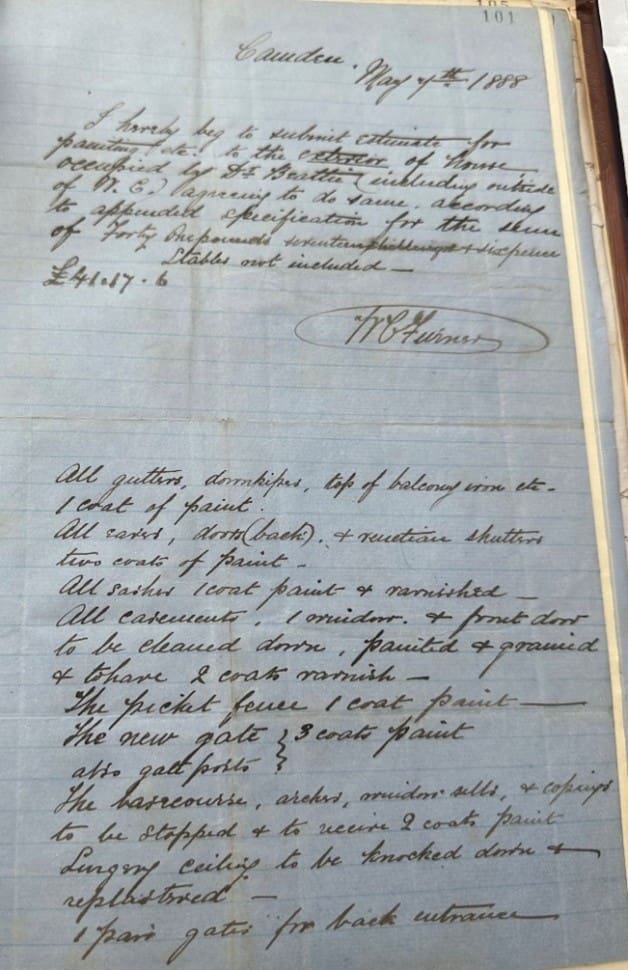
1888 – George Furner Quote of some 41 Pounds to undertake some painting, plastering and minor maintenance.
Why such a grand residence would be built and for what purpose? I am not sure if we will ever be able to answer this question definitively. Though rest assured, I will endeavour to unearth as many stories as possible during my tenure as the custodian of this magical estate. Collating and collecting all the accounts and facts, to continually grow Camden’s historical knowledge of Dr Crookston’s House, has become somewhat of an obsession.
At this juncture, I can supply to you, my theory on the above question. This assumption having two working parts, that in ways share a similar goal. In simplicity the end game is to have a grand and ornamental residence located in the heart of the town, sitting directly under the towns iconic St Johns Anglican Church, within the grand estate will reside a doctor.
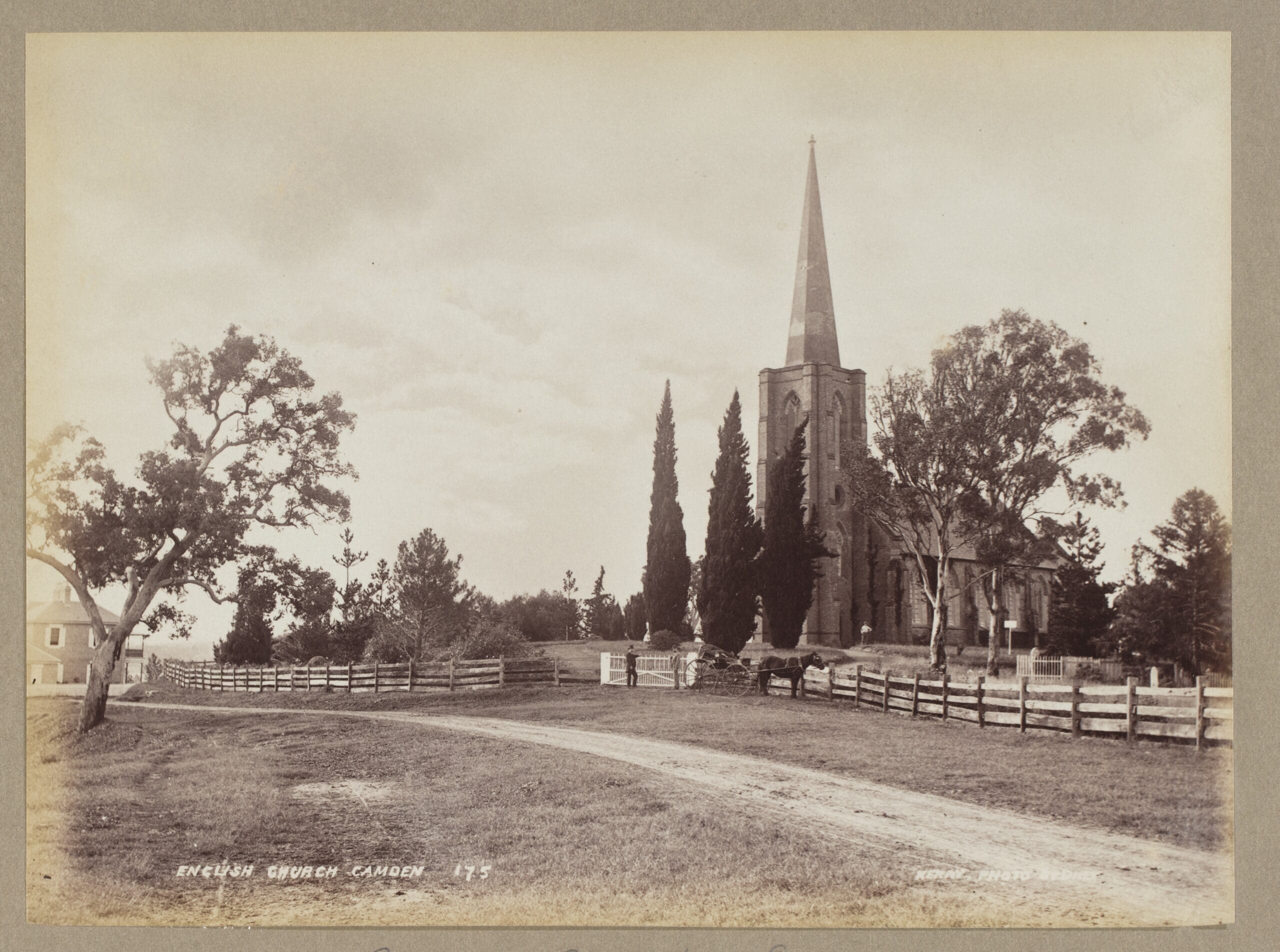
Circa 1883 – St Johns Church and in it’s shadow sits 75 John Street.
Part 1 – During the timeframe of the 1870s, leading into the early 1880s, heads of the Macarthur family and Camden Park Estate, supported by its many notable associates and distinguished families of the Camden region, were hard at work establishing a tram line to the town, along with many other commendable pursuits. This tram line would connect Camden to Sydney, opening the gateway for more money to flood into the town.
Within days after the grand opening of the tram line in March 1882, the Camden Park Estate, would put in motion another plan. This plan was to conduct an auction on vast amounts of land throughout the Camden region. This included many lots positioned in the heart of the township. The estate would create official auction brochures and paraphernalia to help entice Sydneysiders to come and settle in the township of Camden.
On these very brochures of 1882, it would not only provide detail on the blocks that were available for purchase but would also highlight the attractions of the town. Notable establishments such as Hotels, Telegraph Office, Stores, Banks, Town Hall, Churches, Post Office, Police Station, Court House, Public School and of course Doctors, would all be listed! These highlights would prove alluring to possible future residents, maybe persuading them to feel comfortable in such a move out to Camden from the haven of Sydney. These auctions would be held “Next to St Johns Church” in the very shadows of this property.
From all my research of this period, the Macarthur Family are most definitely planned, organised and astute businessmen. I feel the building of this home was always a part (albeit a small one) of the master plan of selling more blocks of land in the Camden district. This house would be placed along with St Johns Church right in the eyeline of all prospective buyers, as they bid at the town’s 1882 auction for parcels of town land. The house no doubt imposed a sense of grandeur along with English country charm. One could think it would have also helped motivate buyers with a sense of what could be? if they made that leap of faith. More importantly to feel comfort, that the town must have somewhat of a distinguished and learned medical man if he was to reside in such a home.
To me it was well laid out sales tactics, all part of a master plan, however I do also feel there just may have been more to the story of this home and why it came to be. A tale of drama and conquest with basis of a good western (minus the gun fight) might have spawned the blueprint of this estate.
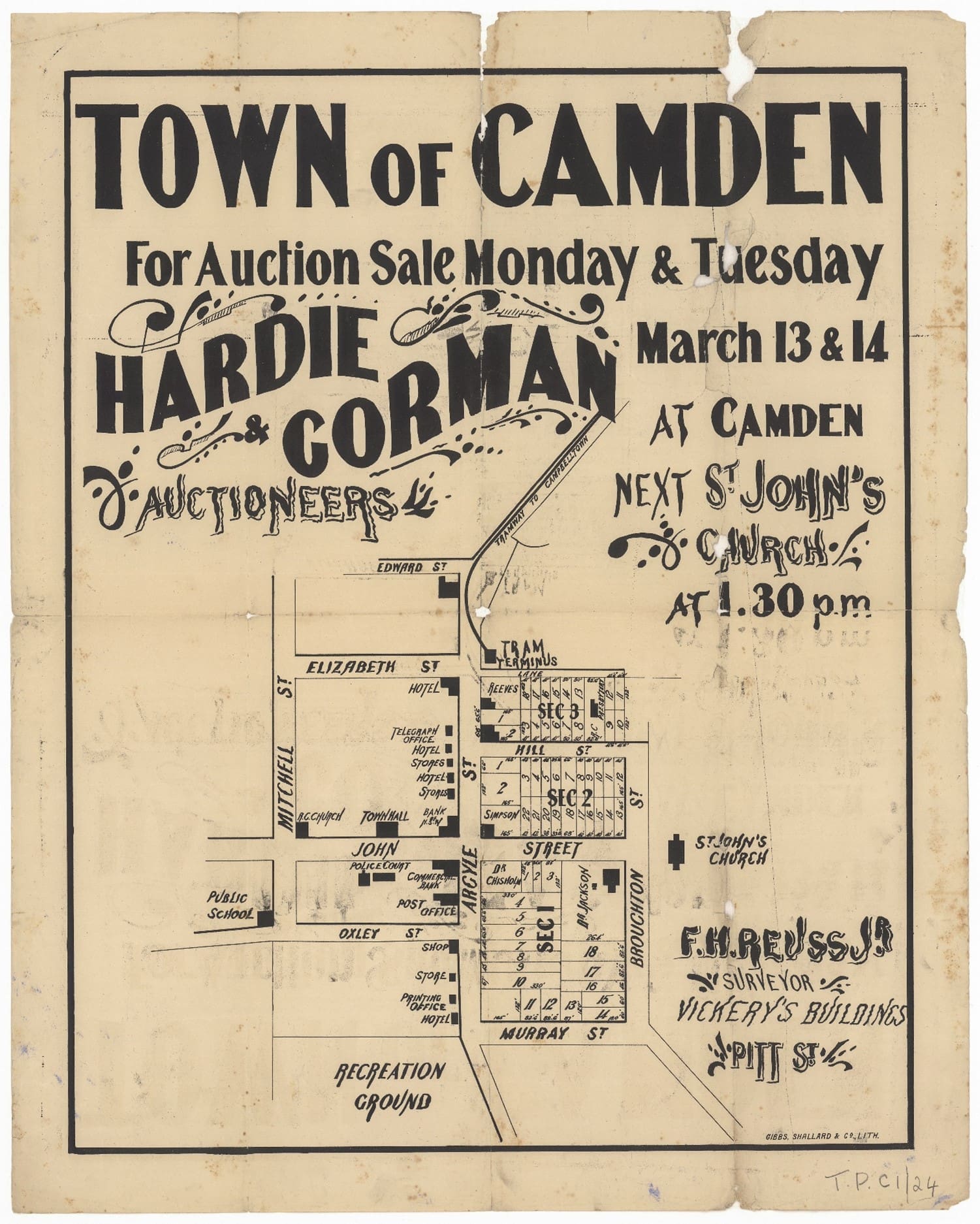
Town Sales Map 1882 – Note Dr Jackson listed at 75 John Street Camden.
Part 2 – Like any good story, it’s always more exciting if something a little more sinister was afoot, it always makes for compelling reading. Within this I give you my 2nd part to an intriguing tale. In the future I plan to write much more on this subject, but for now I will summarise as best I can to help paint an ever-expanding picture that is bubbling away in my mind.
Circa 1876 Dr George Goode purchases a medical practice in Camden from one Dr Edwin Chisholm and so would start his tenure as a medical man in the Camden district. I am yet to research Dr Goode’s time before Camden in definite detail but have found loose snippets of information, which contains him working for the New Zealand government regarding immigration into Australia, having been born, raised, and educated in Ireland. He would spend many years as a medical doctor within Camden over two periods of his life, at one stage living at Macaria which he used to refer to as Enfield House. Dr Goode, I believe to be one of the main characters of the origin story of 75 John Street. Pending your view or alignment he could be considered either the hero or the villain. His character traits could be said to be either “an educated man with an exemplary moral compass, puts others before self, clearly understanding right from wrong, feels social status or an elite standing should not impact the way one treats others, is willing to not bow down in the face of bureaucracy and will fight for any cause he believes in with utmost integrity” or on the other hand he could be considered “The angry Irishman, besotted with self-induced fame, jealous of those considered of higher standing, trouble maker that enjoys to rattle the cage of authority and takes pleasure in driving a wedge between those considered a common man and those considered the Camden elite”. No matter either position, my belief is he is the catalyst to why this very home may have been built. The first notable fractured relationship is well documented between Dr Goode and the Chisholm family (mainly that of James Kinghorn Chisholm) appears in February 1881 of the Campbelltown Herald. This “days-of-our-lives drama”, with pinches of Shakespeare and references to the Bible, seems to have started in 1876 and evolves for many years, building up to the crescendo of the 1881 public spat, all reported in a local paper.
However the beginning of this story seems very amicable. Dr Goode would spend many nights at the home of Dr Edwin Chisholm reviewing the medical practice he was inquiring to purchase, enjoying the hospitality of another medical man whilst perusing client lists, financial documents and understanding the community he may soon become a part of, and eventually would go ahead and do so.
From numerous articles read, it appears the relationship between Dr Goode and the Chisholm family mainly that of Dr Edwin Chisholm and James Kinghorn Chisholm would head south quickly and in dramatic fashion (think crashes, court cases, verbal altercations in public, newspaper slander, town hall meetings, con men, forged documents, white lies to government officials, innocent deaths, public school house disputes, breaking of contracts and a house on a hill?). It is my belief, this quarrel that began between Dr Goode and the distinguished Chisholm family seemed to emanate and flow through to most notable families of the district, including to eventually that of the highest order the Macarthur family.
Dr Goode and his stubborn belief to stand up against local bureaucracy seemed to place him in many hostile situations with Camden’s well-known elite. It is interesting to note, that Dr Goode on nearly every occasion, when elevating some of these matters to the supreme court, or even if being taken to court by these distinguished gentlemen, in most instances won!
A rough timeline of events takes place as follows:
1. 1876: Dr George Goode purchases the practice of Dr Edwin Chisholm of Camden. The purchase seems to relate to a certain list of clients along with goodwill. Many of these clients seem to be notable and distinguished families of Camden. He would also occupy positions of Medical Officer and Vaccinator for the District of Camden, Narellan and Picton – Relieving Edwin Chisholm.
2. 1876 – 1877: James Kinghorn Chisholm relation of Dr Edwin Chisholm is one of these notable clients. Previously his relation Dr Edwin Chisholm had provided free medical services. Dr Goode refused to treat Camden elite for no charge, and this would appear to start an unlikely chain of events.
3. 1876 – 1877: James Chisholm appears to then lead a campaign to stop all their privileged friends consulting Dr Goode, in a bid to stifle his practice. Dr Goode stated that this sadly in his opinion led to many deaths of innocent lives that could have been prevented by his consultation.
4. 1877: The driver of James Chisholm would be accused of purposely running Dr Goode off the road with the use of a horse and cart owned by James Chisholm. Dr Goode would report this would cause substantial damage to his buggy and he was lucky to escape with no serious injury. Once Dr Goode had his buggy repaired, he sent the bill to James Chisholm to pay. James Chisholm refused the full amount but offered to pay a third of the costs. Eventually after a newspaper stoush some four years later, he then paid the full amount.
5. 1878 – 1881: James Chisholm would campaign to get his relative Dr Edwin Chisholm to restart his practice to try to provide opposition to Dr Goode. This would not occur due to legalities on the initial sale of his business. Dr Chisholm was not allowed to conduct a medical practice within 30 miles of Camden.
6. 1878 A certain house would begin construction, maybe the plan was to indeed try to bring Dr Edwin Chisholm to this house but to no avail due to legalities of the time.
It would surprise no one that instead another medical man would be brought to the township of Camden around April 1877, and from above reports by Dr Goode – he states that three to four additional medical men were lured to town in what appeared to be a vain attempt to again disrupt his business. This gentleman in April 1877 would be Dr Selby Mars Morton. Dr Morton a highly regarded medical practitioner of Goulburn for many years had held many important positions in the Goulburn community such as Government Medical Officer, Coroner, Goulburn Jail surgeon, along with owning his own dispensary. Dr Morton would then move his practice to Grafton circa 1876 to provide a more comfortable climate for his wife who was ill at the time. It is this very doctor that would be referenced in January 1878 regarding for whom the house was being built. It’s plausible the elite of the Camden area may have brought Dr Morton to town to provide some competition to Dr Goode, the allure of being able to live in a new, purpose built, beautiful home in the heart of Camden would have been no doubt extremely enticing if it was offered. Dr Morton was more than likely beknown to the Chisholm family; they may have crossed paths with Dr Morton previously during his many years in Goulburn.
Dr Morton however would only last around 18 months in Camden leaving by October 1878 to return to Goulburn. Dr Morton was heralded many times in the local papers of Goulburn, Grafton, and Camden of being an absolute first-class medical practitioner and even more importantly a genuinely nice person. Dr Morton on all counts would have most definitely provided excellent competition for Dr Goode in regard to the admiration of the local town folk. The question is why did he leave?
It makes you wonder did Dr Morton head south due to a deep longing to return to Goulburn? Did he leave as he wished not to be used as a pawn in a local political struggle for power? Maybe he thought Dr Goode was receiving the rough end of a bureaucratic stick? Did he feel uncomfortable to be at the beck and call of the most highly regarded men of the region, or maybe none of the above, maybe I am just barking up the wrong tree.
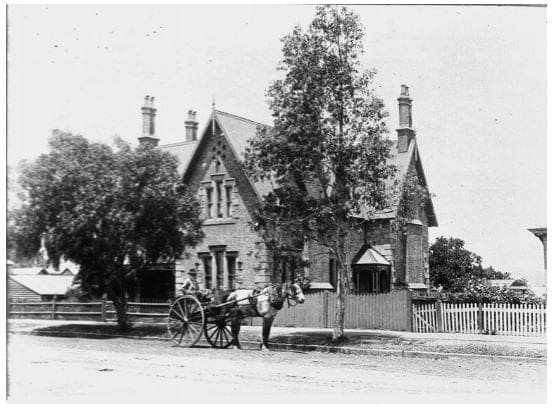
Dr George Goode resides at Macaria – He calls the home Enfield House.
During 1879 more local fighting would arise and this would consist of Dr Goode against more of Camden’s elite. Most notoriously a fight beginning in 1879 but ending in court in 1881 saw a public battle for the ages between Dr Goode and Captain Arthur Onslow. This public stoush was over numerous different and varying categories such as –
1. Captain Onslow and his attempt to be re-elected for the District of Camden in 1879 and Dr Goode publicly expressing he felt this was not done fairly or in a sportsman like manner.
2. Camden Park Estate School and the poor hygiene and modesty issues of the school’s water closet coupled with poor learning conditions such as lighting and flooring as reported by Dr Goode.
3. General slander of each other in the public newspapers.
4. The addition of numerous medical men to the district, up to at least three or four rumoured to have been brought to town by the Camden elite.
5. Various personal clashes around the district.
6. Attempts by Captain Onslow to have the government rescind the positions Dr Goode occupied on their behalf such as Government Medical Officer.
7. Attempts to stop Dr Goode accessing sick patients if he required to pass through Camden Park Estate land to see them.
8. The Camden elite campaigning to stop any of their notable friends seeing Dr Goode whilst he was the only doctor in the district. According to Dr Goode this led to many deaths that could have been prevented.
Without dissecting and going into definitive detail which I will do in the future, Dr Goode in fact won the court case and was paid 1250 pounds worth of damages. This figure is astronomical for 1881 when the court case was concluded. During the case, the presiding judge seems to refer and believe that Onslow was in fact using his position of power to destroy Dr Goode’s practice and reputation in the town.
It is my opinion this heated battle between Dr Goode and Captain Onslow, most likely stems from the original clash of Goode and Messrs Chisholm. Messrs Chisholm were long-time and esteemed friends of the Macarthur and Onslow families. One could believe Captain Onslow tried to put Dr Goode in his place! Unfortunately for Captain Onslow he got more than he bargained for in this Irish firebrand.
After Dr Morton leaves quite suddenly, it appears Dr William John Jackson is the lucky candidate to fill what would appear some quite big shoes. Dr Jackson, unlike Dr Morton, is a strange selection. Dr Jackson has only been qualified for one month maybe a little longer, when he arrives in Camden, March 1879. Within less than a three-year period, the following would occur for a man of minimal medical experience and or qualification –
1. February 1879 listed as a qualified medical practitioner.
2. March 1879 arrives Camden as a doctor for the town.
3. May 1880 listed as a Vaccinator for Campbelltown.
4. December 1880 first known occupant of 75 John Street, Camden
5. August 1881 appears in trial of Goode vs Onslow in support of Onslow. Even loosely implied of possibly being involved with a coverup in the trial. Seen near Schools water closet with Captain Onslow just before jury are to inspect. Strong odour of a chemical like that of Lime of Chloride seem to radiate from this certain closet. Did Dr Jackson pour something in the toilet???
6. October 1881 appointed coroner of Camden.
7. March 1882 attends Camden Tram crash to help injured passengers returning home from Camden Park Estate land sales. Fights with one Dr Goode whilst at the scene of the accident.
8. July 1882 leaves Camden due to practice failing after Dr Goode accuses him of not being suitably qualified for his role as the local coroner let alone as a medical doctor.
9. December 1882 Dr Goode in court successfully proves that some of Dr Jackson’s credentials and certificates are in fact forged, other certificates are left in huge doubt of their authenticity. The presiding judge mentions that Dr Jackson is lucky he chose not to appear at the final hearing, as he most likely would have faced criminal trial. He also mentioned had the medical board known the information that is now apparent, there is no way he would have ever been granted his qualification in Australia….
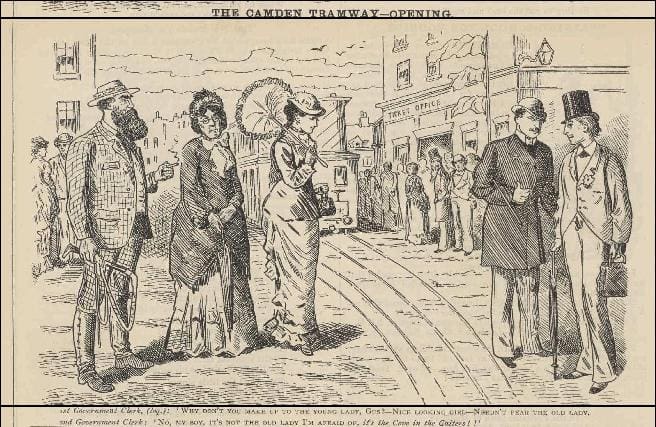
Opening of Camden Tramway 1882.
It appears a high possibility that Dr Jackson was in some ways actually a con man! It also seems apparent the normal diligent checks were not conducted by the elite of Camden, before they rushed Dr Jackson through into so many highly regarded positions within the community and allowed him residency in this proud home of 75 John Street, Camden. It feels in ways, the dire distain for Dr Goode, seemed to cloud the judgement of so many intelligent men, in what appears to be an act of power and control, more so than for the good of the community. This unfortunate mis sight would end with Dr Jackson being run out of town by none other than Dr Goode, in another successful court case. With still around 18 months left on his lease, Dr Jackson would vacate to Windsor. Within a year he seems to disappear from history? As any good con man, maybe he changes profession?
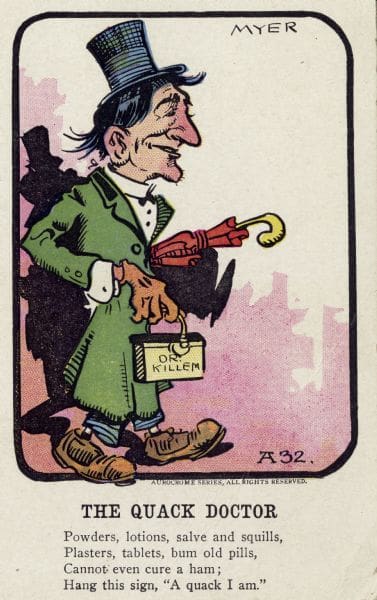
No doubt what Dr Goode thought of Dr Jackson.
By the end of 1882 with all the court cases complete, also coinciding unfortunately with the passing of both Captain Onslow and Sir William Macarthur, the owner of the house was now one Elizabeth Macarthur Onslow. I am unsure whether it is Elizabeth’s calming influence, intelligence, or just good luck, but the next doctor to reside in this home from September 1882 all the way until 1895 is a Dr Robert Ettingsall Beattie.
Dr Beattie came with a list of exemplary achievements and qualifications; no fighting can ever be found between himself and Dr Goode. In fact, if anything Dr Beattie appeared to be the perfect match for his contemporary. Dr Beattie was the same nationality and faith as Dr Goode and had qualifications and experience that possibly trumped that of his compatriot. It would appear, if in fact Elizabeth had chosen Dr Beattie, she had done a most wonderful job, it could be said the diligent checks this time were conducted, and in an exceptional way.
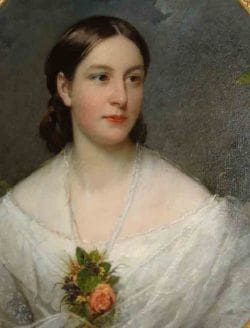
Elizabeth Macarthur Onslow
In summary, with all that has been read and gathered about of all parties involved with this home, from before its inception around 1876 all the way to the 1890s, I firmly believe it was always built to be a doctor’s residence for the town of Camden. Whether that be because of its first newspaper reports, its first signed lease, the war with Dr Goode, the town auction, town maps of the era, the long line of doctors to continually occupy the home, the known quotes for upkeep of the surgery. No matter what path one chooses, it always ends up with a doctor residing at the home.
I believe in some way, it was part of a master plan to help attract, lure, impress, future investors to buy at the Camden Park Estate land sales of 1882. It was also to provide another benefit to the township of Camden from the esteemed Macarthur family. Lastly, I also believe that another reason for the building of this home was to try to wrestle back some power in a medical and political sense from a certain Dr Goode. The grand residence to be able to house a medical man that maybe would be a little more aligned with the values and direction of the Camden elite? Maybe a doctor to bow in the presence of local greatness.
In some ways, if this house did evolve, from the possibility, of a more than likely a trivial visit, from one James Kinghorn Chisholm to a certain Dr Goode on one fine day in Camden, and Mr Chisholm leaving not happy with services rendered, and fees charged. Well, that would make for one hell of a story. It would also help maybe draw a line and connect a dot as to why this house was built in such a grand and revered position and built by some of Camden’s finest craftsman ever, the Furner family. This build would need to be substantial and ornamental as requested by Sir William Macarthur as it would need to compete against another fine Camden residence, that of Macaria where Dr George Goode resided. If the deep seeded plan was to take back over the lion’s share of medical business of the town, this home and the doctor to reside within it, would have to be of the highest order to stand a chance.
Shane Smith
PS – Note on the town map the additional interesting facts – look below and see.
1. Dr Goode IS NOT referenced even though he is a doctor of Camden for six years and resides in Macaria in a beautiful home in the centre of the town.
2. Dr Edwin Chisholm is referenced but he no longer practices in Camden?
3. Dr Jackson the possible con man, referenced at 75 John Street, Camden

References for Article
The Cumberland Mercury – 26th of January 1878 – House being built by Sir William Macarthur – https://trove.nla.gov.au/newspaper/article/248613125?searchTerm=Morton
Australian Town and Country Journal – 28th of February 1880 – Fine residence upon Church Hill – https://trove.nla.gov.au/newspaper/article/70941443?searchTerm=Church%20Hill%20Camden
Camden History Journal Vol 5 No 1, March 2021. – Memories of Camden Park Estate Ada Australia Goldsmith. P 37 – https://www.camdenhistory.org.au/chsjournal.html
Sydney Morning Herald – 15th of December 1887 – R.H.Druitt selling Calves in Picton – https://trove.nla.gov.au/newspaper/article/13677326?searchTerm=Picton%20Calve%20Esq%20Druitt
NSW Government Gazette – 4th of March 1892 – R.H.Druitt at Spring Mill, The Oaks – https://trove.nla.gov.au/newspaper/article/222040779?searchTerm=%22Spring%20Mill%22%20Druitt
Evening News – 6th of May 1891 – R.H.Druitt president of The Oaks School of arts – https://trove.nla.gov.au/newspaper/article/113888851?searchTerm=Oaks%20%22R%20H%20Druitt%22%20church
Camden News – 5th of October 1899 – R.H.Druitt gored by bull – https://trove.nla.gov.au/newspaper/article/133053482?searchTerm=%22Gored%20by%20a%20bull%22
The Cumberland Mercury – 11th of October 1878 – Dr Morton leaves Camden – https://trove.nla.gov.au/newspaper/article/248615150?searchTerm=Morton%20camden
NSW Government Gazette – 19th of April 1876 – Dr George Goode Camden Medical Officer, vice Edwin Chisholm – https://trove.nla.gov.au/newspaper/article/223648960?searchTerm=%22Edwin%20Chisholm%22
The Sydney Morning Herald – 5th of April 1876 – Dr Goode has purhased Dr Chisholm’s practice – https://trove.nla.gov.au/newspaper/article/13367633?searchTerm=Chisholm%20Goode
The Campbelltown Herald – 19th of February 1881 – Dr Goode vs Messrs Chisholm in back and forth newspaper stoush – https://trove.nla.gov.au/newspaper/article/103354320?searchTerm=Chisholm%20Goode
The Campbelltown Herald – 10th of August 1881 – Goode vs Onslow court case – https://trove.nla.gov.au/newspaper/article/103354185/10924250
The Cumberland Mercury – 15th of March 1879 – Dr Jackson arrives Camden – https://trove.nla.gov.au/newspaper/article/248616348?searchTerm=Dr%20Jackson%20Camden
The Cumberland Mercury – 15th of February 1879 – Dr Jackson legaly qualified medical practicioner – https://trove.nla.gov.au/newspaper/article/248616152?searchTerm=%22W%20J%20Jackson%22
The Sydney Daily Telegraph – 1st of May 1880 – Dr Jackson vaccinator to Campbelltown – https://trove.nla.gov.au/newspaper/article/238484109?searchTerm=Dr%20William%20Jackson
NSW Government Gazette – 25th of October 1881 – Dr Jackson Camden Coroner – https://trove.nla.gov.au/newspaper/article/221621776?searchTerm=Dr%20William%20Jackson%20coroner
Evening News – 14th of March 1882 – Tramway Accident Camden – https://trove.nla.gov.au/newspaper/article/107988855?searchTerm=Jackson%20Goode%20Tram%20Camden#
The Sydney Morning Herald – 7th of December 1882 – Jackson v. Goode court case – https://trove.nla.gov.au/newspaper/article/13519591?searchTerm=Jackson%20Goode%20Tram%20Camden
Every stay has a story
Explore our charming collection of boutique accommodation options nestled amongst some of Southern Sydney’s most beautiful destinations.

